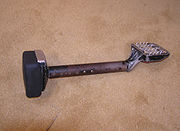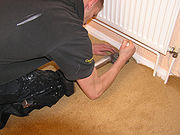
Fitted carpet
Encyclopedia


Carpet
A carpet is a textile floor covering consisting of an upper layer of "pile" attached to a backing. The pile is generally either made from wool or a manmade fibre such as polypropylene,nylon or polyester and usually consists of twisted tufts which are often heat-treated to maintain their...
intended to cover a floor
Flooring
Flooring is the general term for a permanent covering of a floor, or for the work of installing such a floor covering. Floor covering is a term to generically describe any finish material applied over a floor structure to provide a walking surface...
entirely. In most western countries a
"Carpet Layer" or "Carpet Fitter" is usually required to complete a 4 year apprenticeship. Carpet over 4 meters in length is usually installed with the use of a "Power Stretcher" (tubed or tubeless).
Fitted carpets offer comfort and some soundproofing
Soundproofing
Soundproofing is any means of reducing the sound pressure with respect to a specified sound source and receptor. There are several basic approaches to reducing sound: increasing the distance between source and receiver, using noise barriers to reflect or absorb the energy of the sound waves, using...
, they are however hard to clean, and can trap dirt and mites, sometimes causing allergic reactions.
Fitted carpets were originally woven to the dimensions of the specific area they were covering. They were later made in smaller strips, around the time stair carpet became popular, and woven at the site of the job by the carpet fitter. These carpets were then held in place with individually nailed tacks driven through the carpet around the perimeter and occasionally small rings in the carpet which were folded over.
The introduction of 'smoothedge' also known as 'tackless strips' or 'gripper strip' simplified the installation of wall-to-wall carpeting, increasing the neatness of the finish at the wall. Because tackless strips are essentially the same thickness as underlay, using tackless strips yields a level edge, whereas tacking gives an uneven edge.
Tackless strip is a 5' X 1" strip of wood bevelled on one edge with many small tacks protruding through from the bottom. Tackless does not refer to the object itself, but to its ability to hold a carpet in place without tacks through the carpet. It is placed around the perimeter of the area to be carpeted, with the bevelled edge side nearest the wall and held in place with nails (timber floors) or glue (concrete floor). The carpet fits over it (held on the tacks) and is wedged into the narrow gully left between the wall and bevelled side giving a smooth edge. Tackless strips allow stretching of the carpet during installation, greatly improving the appearance of the installation. Stretching can be performed with the use of a power stretcher or a manual knee-kicker.
Gluing without underlay or gripper is simpler as the carpet is cut to the wall by the fitter and glued underneath.

